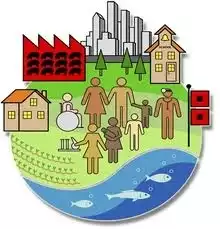Community-Based Research: Reducing Campus GHG Emissions
Initial Publication Date: April 29, 2016
Summary

![[creative commons]](/images/creativecommons_16.png)
Provenance: Eli Maynard
Reuse: This item is offered under a Creative Commons Attribution-NonCommercial-ShareAlike license http://creativecommons.org/licenses/by-nc-sa/3.0/ You may reuse this item for non-commercial purposes as long as you provide attribution and offer any derivative works under a similar license.
Students, working as a consulting team, carryout a semester-long Community-Based Research (CBR) project in which they research options for reducing campus greenhouse gas emissions, develop recommendations, and present them to campus operations staff and senior officers of the college. Students meet and work with facilities management staff to focus their research in ways that are useful to the college.
The assignment was given in the course Practicum in Sustainability – Reducing Dickinson's Carbon Footprint, taught by Neil Leary in fall 2012 at Dickinson College. The course syllabus and other course materials are available on the Cooling the Curriculum portal: http://communities.earthportal.org/changingclimate/.
Learning Goals
Learning goals are for students to be able to:
- Develop and execute a research plan that serves the needs of a community (Dickinson College in this case);
- Evaluate options for reducing greenhouse gas emissions using criteria relevant to campus stakeholders;
- Work effectively as a member of a team to develop recommendations for climate change action that are supported by credible evidence, good analysis and well reasoned arguments;
- Communicate recommendations effectively to community members and decisions makers.
Context for Use
Community-based research is a pedagogy in which students engage with members of a community to design and carryout a research activity that benefits both the students and the partner community. In this project, the community is the college community and the key stakeholders to be engaged in the research are campus operations staff and senior officers of the college. To be effective, the instructor should meet with these stakeholders prior to the start of the semester to reach common understanding of the purposes of the project, identify research topics that are feasible and beneficial to the college, agree on if/how stakeholders will assist students in their research, and set realistic expectations. Arranging for students to meet with campus operations staff and senior officers at the start of the semester, and to present their recommendations to these stakeholders at the end of the semester, can motivate students to perform at a high level.
Description and Teaching Materials
Instructions and assessment rubric are provided for this semester-long community-based research (CBR) project.
Assignment Instructions for CBR project
CBR_Project.pdf
Rubric for CBR project
Rubric_CBR_Project.docx
Teaching Notes and Tips
Community-based research is a pedagogy in which students engage with members of a community to design and carryout a research activity that benefits both the students and the partner community. In this project, the community is the college community and the key stakeholders to be engaged in the research are campus operations staff and senior officers of the college. To be effective, the instructor should meet with these stakeholders prior to the start of the semester to reach common understanding of the purposes of the project, identify research topics that are feasible and beneficial to the college, agree on if/how stakeholders will assist students in their research, and set realistic expectations. Arranging for students to meet with campus operations staff and senior officers at the start of the semester, and to present their recommendations to these stakeholders at the end of the semester, can motivate students to perform at a high level.
Assessment
Performance on the CBR-project was assessed using a rubric; see attachment above.
References and Resources
Citation
Leary, N. (2013). Community-Based Research: Reducing Campus GHG Emissions. Retrieved from http://www.camelclimatechange.org/view/assignment/51cbfb8e7896bb431f6bfbb1


![[creative commons]](/images/creativecommons_16.png)